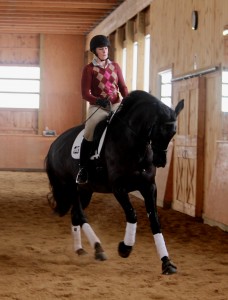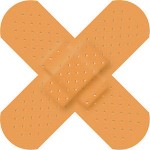Lessons I’ve Learned
Toe Flicking
April 14, 2014 by
Dressage horses are truly beautiful. When we watch these horses move with so much impulsion, balance and cadence it is easy to misinterpret some things we see. One of these instances is toe flicking. This is when at the completion of the stride, the horse flicks his front toes up towards the sky. In some horses, you can almost see the sole of their foot. The appearance of “toe flicking” can be used as a diagnostic tool for the rider or judge. This is most often seen in the medium or extended trot but more and more commonly in the collected trot. If you find your horse is flicking its toes, you can be almost positive that you have lost its shoulders and that the horse is on the forehand. The momentum has dropped down from the topline and into the horse’s elbows and the horse no longer has that wonderful, ground covering, “front crawl” feeling.
There are many exercises to help fix this occurrence but a very simple exercise is to work the extended trot on the long wall. Begin the long wall in shoulder-in, as you begin to increase the impulsion and ask for more ground cover, allow the horse to straighten. As soon as you feel you are losing the shoulders, push the horse back into the shoulder-in position. As you repeat this exercise, you will be able to go longer and longer in straightness with the shoulders up.
*For another exercise to keep your horse’s shoulders up, please see my article How to Achieve a Soft Back.
Why clinics should be part of your program
by
Today I taught a really great lesson! I owe a great deal of today’s success to the work my student did with another coach at a clinic she attended. This clinic was focused on the biomechanics of the rider but the clinician made some very astute observations about the overall appearance of my student’s ride that really hit home for her. In light of my student’s experience, I wanted to discuss what makes a clinic situation so great and why it should be a part of every rider’s training program.
Each rider, coach and trainer has had a different set of experiences. They have drawn their knowledge not only from all of the different instructors they have worked with but also from the horses they have ridden. Every horse a rider is presented with will teach them something, will humble them somehow and will contribute to the journey they take as well as the one they send their students on. Dressage is one of those things that you could never master; no matter how many lifetimes you live. This is why we have to collectively work together to try and gain as much knowledge as we can in the time we have. The knowledge that I have obtained is not just mine. It comes from the hours of work, dedication and love of the sport that those who have taught me have put in. This sport is in its essence, a team sport and should be looked at as such. It is not the knowledge of one rider that breeds success but the knowledge of all of those that have come before them.

Summer and Anastacia riding with clinician Christian Garweg
Often when a coach works with a student for a long period of time, they become blind to some of the habits that the horses and riders form. An outside perspective can help refocus the coach on an area that needs work but has perhaps been overlooked. This could be something simple like a hand that is held in a strange position but has a large affect on the overall success of the ride. For instance, that hand could be breaking the connection in every half-halt because the altered hand position makes it stronger than the other hand. These small inconsistencies can have dramatic results in improving the ride but may have overlooked by your regular coach. When coaching someone on a regular basis you become accustomed to the students idiosyncrasies and they begin to appear “normal”. A new set of eyes can really help keep you and your regular coach focused on the right things.
One of the things I find most interesting when I ride in clinics myself or when I watch my students work with other coaches, is that sometimes the right words make all the difference in the world to understanding a concept. This only makes sense. We all learn in different ways. We all have our own set of experiences that define our knowledge and impact how we interpret what we hear so it only makes sense that hearing the same thing said in a different way, will change how we hear it and understand it. Frequently I have been working with my own coach and think I’m doing exactly what she is telling me to do but she keeps on talking about it. Clearly I am missing something and not giving her exactly what she wants to see or she would stop telling me about it. I have often found that by working on the same thing with another coach, I can obtain that epiphany moment. This is not the fault of my regular coach, it is simply that the same thing being said in different words or perhaps in a slightly different circumstance, made the light bulb come on for me. The two coaches can have the exact same end result in mind but often the way it’s said or context it is said in can be the difference between almost getting it and the “Ah ha!” moment.
Finally but most importantly, working with other coaches keeps you inspired! This sport is addictive. It is full of beauty, harmony and compassion. Dressage riders as a whole love to learn and are encouraged by understanding and learning about new things. We are goal oriented and driven. Clinics feed our needs in many of those ways. We get to watch others and become inspired by their success. We set going to a clinic as a goal and prepare to put our best foot forward so that we can gain as much from the experience as possible. We inevitably acquire more knowledge through the clinician and the experience and become excited about the potential we have yet to achieve. Attending a clinic is never a loss. Learning is not based only on our successes, it is found almost more often in our failures. In taking an honest look at what did and did not work for us and understanding why. Learning that something did not work for you is never a step in the wrong direction, in fact it may help you learn more about the root of the problem. So whether you liked what the clinician had to say or not, you will always take something away from having attended!
Allowing your Horse to make Mistakes
December 1, 2013 by
Horses are not all that different from children. In order for a horse to learn, they have to be allowed to make mistakes. If our parents never let us fall down, we never would have learned to walk and later run. When learning multiplication tables, if your a child gets it wrong, you don’t move on to division! It can’t work. It is much the same for horses. If we, as riders are always trying to prevent mistakes, our horses will never learn. We will become responsible for things we shouldn’t be (ie. frame, balance, rhythmn) If this happens we will never be able to ride softly and quietly. We have to allow them to make decisions. They will either make the right choice or the wrong choice. If they make the right choice, Great! The lesson is being learned. If they make the wrong decision, oh well, it just gives us a chance to make a correction and provide the horse another opportunity to learn.

If you feel like you are having to ride really physically all the time, consider how you got there… Have you been accepting responsibility for things you shouldn’t? Are you taking away your horses ability to learn? Let them make mistakes, don’t panic and turn training into a learning process for you both!
Making Appropriate Corrections
October 22, 2013 by
One of the most common mistakes I encounter when teaching happens when riders begin correcting the symptoms of their problems. By this I mean that a rider gets so involved with trying to make everything look perfect, that they lose sight of where the problem actually began.
Imagine you went to the doctor with a compound fracture. The doctor wouldn’t stick a bandage over the bloody bone jutting out of your leg and send you home. That wouldn’t make you any better, it would only make it appear better. It would also lead to all kinds of other symptoms; a limp, infection, pain. He would instead, reset the leg and deal with the source of the problem, the break.

The same idea can be applied to your riding. Let’s say that you are trying to turn down the centre line on the right rein but for some reason every time you try it, your horse ends up two meters off the line, way over flexed to the right and you find yourself in a pretzel like position with your right hand in your lap! What has gone wrong? How did you end up here?
What has happened is that the rider has started slapping Bandaids on the issue and they are not recognizing the source of the problem. The horse isn’t turning, so the rider begins to throw everything they have at the horse in an attempt to improve the situation. It doesn’t work because the rider has missed that this predicament occurred as a result of the horse not responding correctly to the outside aids (turning aids). The proper correction in this case would be to reinforce the outside aids with a kick from the outside leg and a half-halt with the outside rein. This would stop all of the complications seen in the rider’s initial incorrect approach, from ever occurring. Be careful to avoid piling aids on top of aids to fix your problems, it never works! Always try to discover the source of the problem. Continually referring back to your training pyramid will help you with this. If you are having to “muscle” through it, you’re probably heading in the wrong direction.
 As dressage riders we all have this idea that everything has to be beautiful all the time. Well, I’m saying that sometimes you need to “upset the applecart”! Too often we allow our horses to respond incorrectly or not at all to our aids in the pursuit of “pretty”, only to end up compromising our position and therefore our ability to progress within an exercise. Be sure that every aid you apply gets the result it intended. There are few things in dressage training that will take you out at the knees faster than a poorly enforced aid!
As dressage riders we all have this idea that everything has to be beautiful all the time. Well, I’m saying that sometimes you need to “upset the applecart”! Too often we allow our horses to respond incorrectly or not at all to our aids in the pursuit of “pretty”, only to end up compromising our position and therefore our ability to progress within an exercise. Be sure that every aid you apply gets the result it intended. There are few things in dressage training that will take you out at the knees faster than a poorly enforced aid!